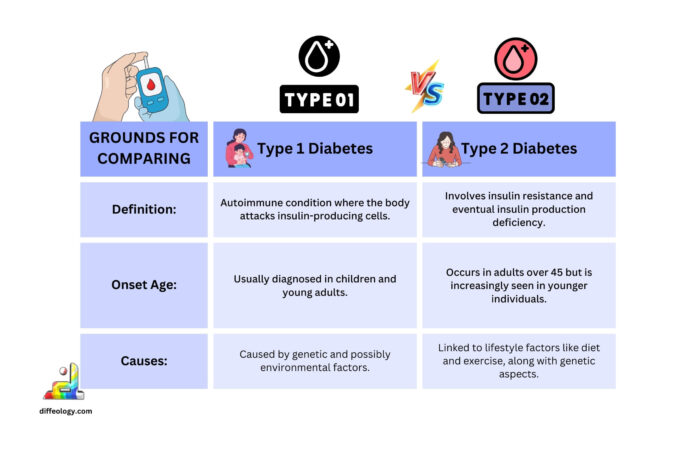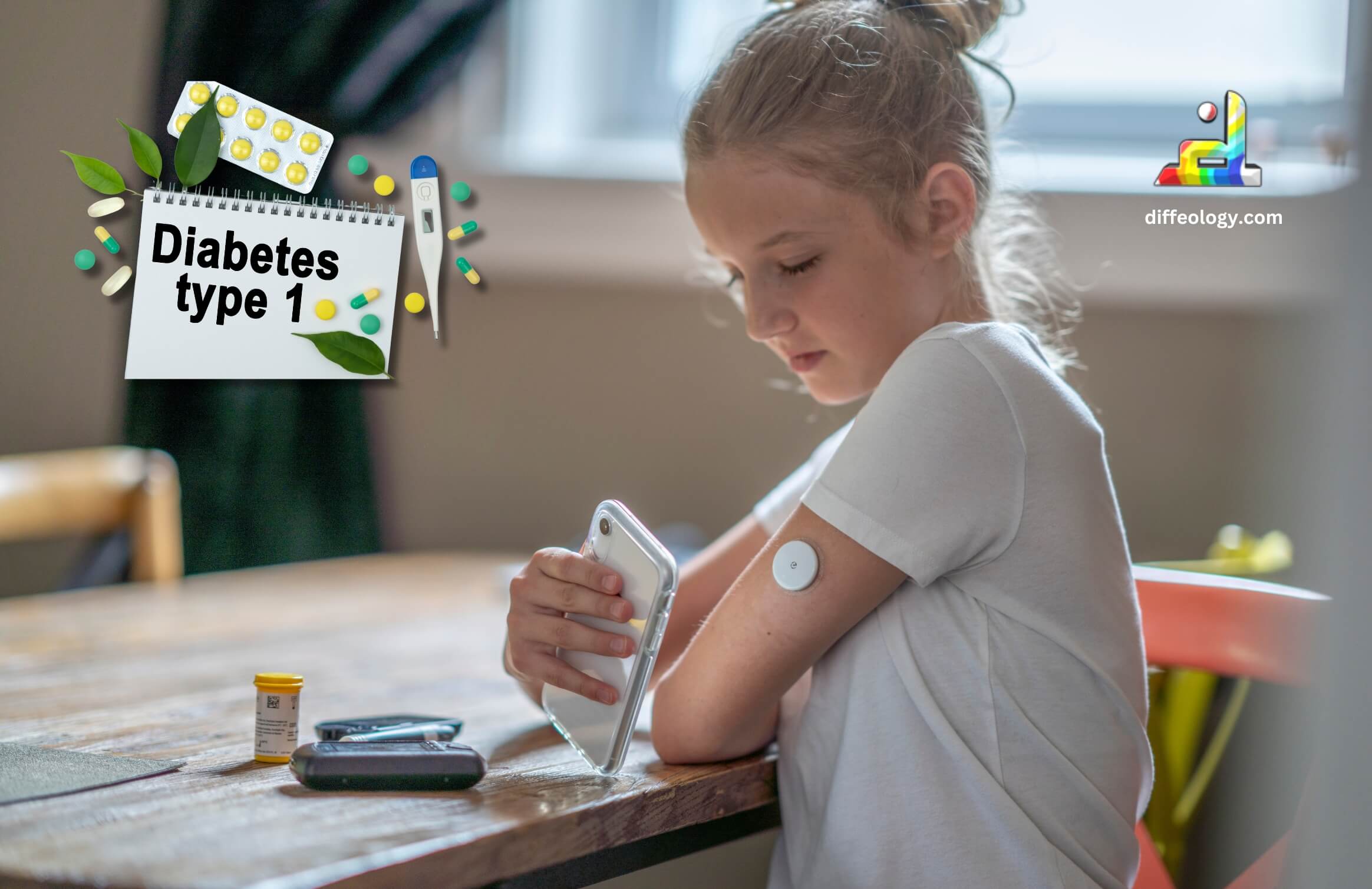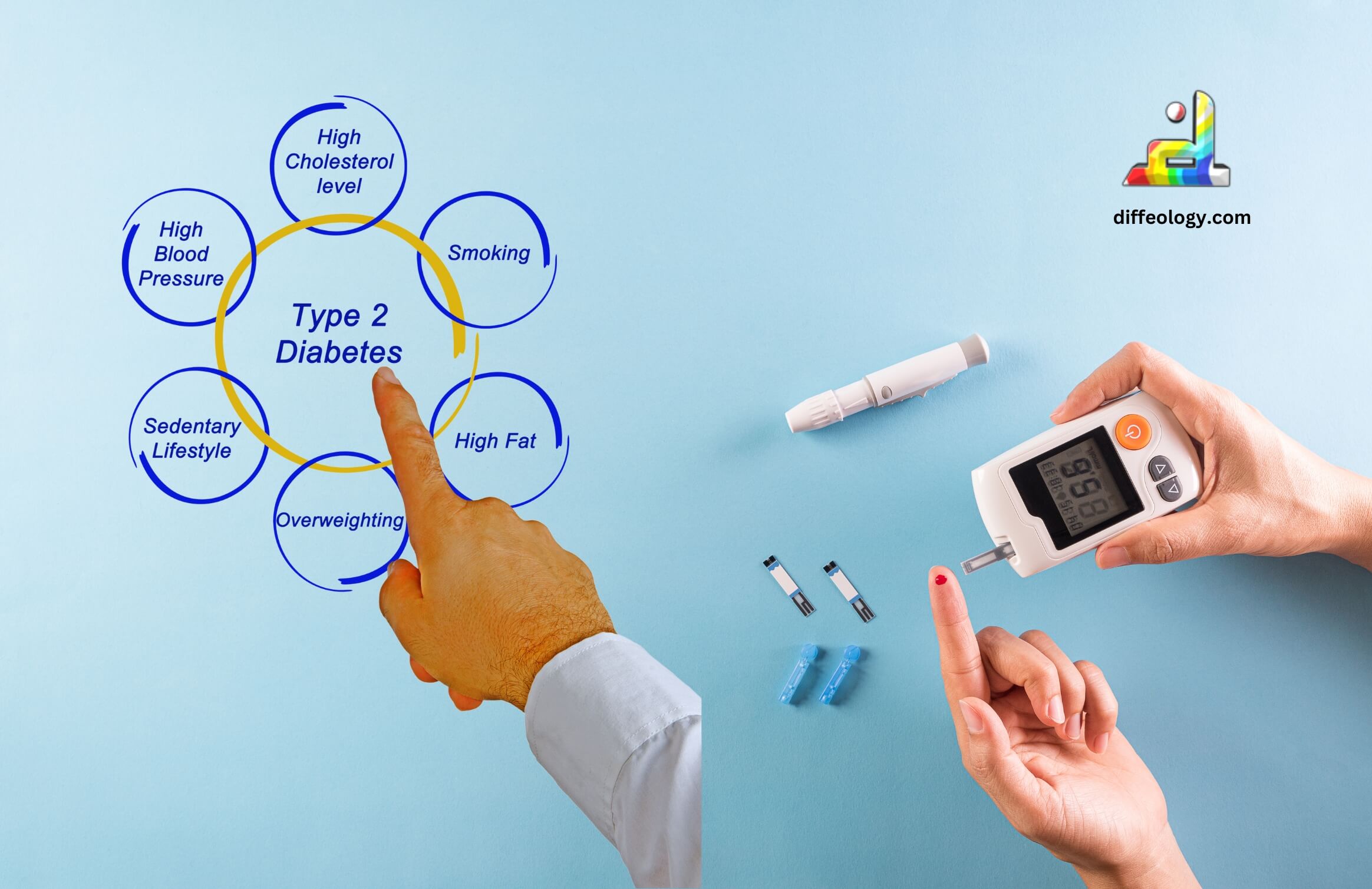Diabetes is a chronic health condition that affects how your body turns food into energy. There are two main types of diabetes: Type 1 and Type 2. The Difference Between Type 1 and Type 2 Diabetes is simple. Type 1 diabetes is less common, affecting about 5-10% of people with diabetes, and usually begins in childhood or young adulthood. It happens when the body’s immune system attacks the cells in the pancreas that make insulin, which is a hormone that helps regulate blood sugar. On the other hand, Type 2 diabetes is much more common, making up about 90-95% of diabetes cases. It typically occurs in adults and is often linked to obesity and lack of physical activity. In Type 2 diabetes, the body either doesn’t use insulin properly or doesn’t make enough of it, leading to high blood sugar levels. Both types of diabetes can lead to serious health problems if not managed properly, but they are treated in different ways.
Main Difference Between Type 1 and Type 2 Diabetes
Type 1 diabetes is an autoimmune condition where the body attacks its insulin-producing cells. Type 2 diabetes is more related to lifestyle factors, such as diet and exercise. In Type 1 diabetes, the body produces little to no insulin. In Type 2 diabetes, the body produces insulin, but it doesn’t use it effectively. Type 1 diabetes usually starts in childhood or early adulthood. Type 2 diabetes often develops in older adults, but it can occur at any age.
Type 1 Vs. Type 2 Diabetes
What is Type 1 Diabetes?
Type 1 diabetes is a chronic condition where the body’s immune system mistakenly attacks and destroys the insulin-producing cells in the pancreas. Insulin is a hormone that helps regulate blood sugar levels by allowing glucose (sugar) to enter cells, where it’s used for energy. Without enough insulin, glucose builds up in the bloodstream, leading to high blood sugar levels. This can cause serious health problems over time, including damage to the heart, blood vessels, nerves, eyes, and kidneys. Type 1 diabetes usually develops in children, teens, or young adults, but it can occur at any age. Unlike Type 2 diabetes, which is often linked to lifestyle factors like diet and exercise, Type 1 is not preventable and is considered an autoimmune disease.
Read Also: Difference Between Dextrose and Glucose
Managing Type 1 diabetes requires daily insulin injections or the use of an insulin pump, along with careful monitoring of blood sugar levels. People with this condition need to check their blood sugar multiple times a day to make sure it stays within a healthy range. According to the American Diabetes Association, around 1.6 million Americans are living with Type 1 diabetes, and the number is growing every year. It’s also important to note that while there’s currently no cure for Type 1 diabetes, advancements in technology and treatment have significantly improved the quality of life for those affected. With proper management, people with Type 1 diabetes can lead full, healthy lives.
What is Type 2 Diabetes?
Type 2 diabetes is a chronic condition that affects how the body processes blood sugar (glucose). In this type of diabetes, the body either doesn’t produce enough insulin or becomes resistant to it. Insulin is a hormone that helps move glucose from the blood into the cells, where it’s used for energy. When the body can’t use insulin properly, glucose builds up in the blood, leading to high blood sugar levels. Over time, this can cause serious complications like heart disease, kidney failure, nerve damage, and vision problems. Type 2 diabetes is the most common form of diabetes, accounting for about 90-95% of all cases. It usually develops in adults over the age of 45, but it’s becoming more common in younger people, including children and teens, due to rising obesity rates and unhealthy lifestyles.
Read Also: Difference Between Insulin and Glucagon
Managing Type 2 diabetes often involves lifestyle changes, such as eating a healthy diet, getting regular exercise, and losing weight. Some people may also need oral medications or insulin injections to help control their blood sugar levels. According to the World Health Organization, more than 422 million people worldwide have diabetes, and the majority of them have Type 2. In the United States alone, over 37 million people are living with diabetes, and about 1.5 million new cases are diagnosed each year. The good news is that with proper management, many people with Type 2 diabetes can lead healthy lives, and in some cases, lifestyle changes can even reverse the condition.
Comparison Table “Type 1 Diabetes Vs. Type 2 Diabetes”
| Onset Age | Usually, in childhood or teens | Usually in adulthood |
| Cause | Autoimmune destruction of insulin cells | Insulin resistance and low insulin |
| Insulin Production | Little to none | Produced, but not used effectively |
| Body Type | Often thin | Often overweight or obese |
| Genetics | Less common | More common |
| Management | Insulin injections | Lifestyle changes, oral meds, insulin |
| Symptoms Speed | Rapid onset | Slow onset |
| Blood Sugar Levels | Highly variable | Usually stable |
| Ketoacidosis Risk | High | Low |
| Main Treatment | Insulin therapy | Diet, exercise, meds, insulin |
| Reversibility | Not reversible | Sometimes reversible with weight loss |
| Common in Children | Yes | No |
| Common in Adults | No | Yes |
| Family History | Less influence | Strong influence |
| Preventable | No | Often preventable with lifestyle |
| Monitoring | Frequent glucose checks | Regular glucose checks |
| Long-term Risks | High | Moderate to high |
Difference Between Type 1 and Type 2 Diabetes in Detail
Get to know the Difference Between Type 1 Vs. Type 2 Diabetes in Detail
1. Cause and Onset of Type 1 vs. Type 2 Diabetes
Type 1 diabetes is an autoimmune disease, meaning the body’s immune system mistakenly attacks and destroys the insulin-producing cells in the pancreas. This type of diabetes usually appears in children and young adults, often suddenly. Since the body can no longer produce insulin, people with Type 1 diabetes must take insulin every day to survive.
In contrast, Type 2 diabetes typically develops over many years and is often linked to lifestyle factors such as poor diet, lack of exercise, and obesity. The pancreas still produces insulin in Type 2 diabetes, but the body’s cells become resistant to its effects. This resistance means glucose builds up in the blood instead of being used for energy, leading to high blood sugar levels.
2. Prevalence and Age of Diagnosis
Type 1 diabetes is less common, affecting only about 5-10% of all people with diabetes. It is usually diagnosed in children, teens, and young adults, with most cases occurring before the age of 20. This type is often referred to as juvenile diabetes because of its early onset.
Type 2 diabetes is much more common, making up about 90-95% of diabetes cases. While it was once primarily diagnosed in adults over 45, it is increasingly being seen in younger people, including children and teens, due to rising obesity rates. Today, Type 2 diabetes can affect people of any age.
3. Symptoms and Detection
The symptoms of Type 1 diabetes tend to develop quickly, over a few weeks or even days. Common symptoms include extreme thirst, frequent urination, rapid weight loss, and fatigue. Because of the sudden onset and severity of symptoms, Type 1 diabetes is often diagnosed quickly after symptoms begin.
In Type 2 diabetes, symptoms can be mild or even absent in the early stages, making it harder to detect. When symptoms do appear, they often include increased thirst, frequent urination, blurred vision, and slow-healing wounds. Because symptoms can be subtle, many people with Type 2 diabetes may not be diagnosed until years after the condition has developed.
4. Insulin and Blood Sugar Management
People with Type 1 diabetes must rely on daily insulin injections or an insulin pump to manage their blood sugar levels. Since their bodies no longer produce insulin, careful monitoring of blood glucose is essential to avoid dangerously high or low levels.
In Type 2 diabetes, management often begins with lifestyle changes, such as improved diet and increased physical activity. Medications, including insulin, may be needed if blood sugar levels cannot be controlled through lifestyle changes alone. Type 2 diabetes management focuses on increasing the body’s sensitivity to insulin or reducing the liver’s glucose production.
5. Genetic and Environmental Factors
Genetics play a significant role in both types of diabetes, but the influence is more pronounced in Type 1. If a close relative has Type 1 diabetes, the chances of developing it are higher, although environmental factors, such as viral infections, are also believed to trigger the disease in genetically susceptible individuals.
For Type 2 diabetes, genetics also contribute, but lifestyle factors like poor diet, lack of exercise, and obesity are much more influential. Having a family history of Type 2 diabetes increases the risk, but making healthy lifestyle choices can significantly lower the chances of developing the disease.
6. Long-Term Complications
Both types of diabetes can lead to serious long-term complications if not properly managed. These complications include heart disease, kidney failure, nerve damage, and vision problems. However, because Type 2 diabetes often goes undetected for years, those with Type 2 diabetes may already have some complications by the time they are diagnosed.
While both types require ongoing management to prevent complications, the risk of developing complications can be reduced by maintaining good blood sugar control, following a healthy diet, exercising regularly, and monitoring blood pressure and cholesterol levels.
7. Treatment Advancements and Future Outlook
Research is ongoing to find better treatments and possibly a cure for both Type 1 and Type 2 diabetes. For Type 1 diabetes, advancements in insulin therapy, including artificial pancreas systems, are helping patients manage their blood sugar levels more effectively. Stem cell research also holds promise for potentially regenerating insulin-producing cells.
In Type 2 diabetes, new medications and lifestyle interventions are being developed to improve insulin sensitivity and prevent disease progression. Education and public health initiatives aimed at reducing obesity and promoting healthy lifestyles are also crucial in combating the rise of Type 2 diabetes, particularly among younger populations.
Key Differences Between Type 1 and Type 2 Diabetes
● Weight: People with Type 1 diabetes are usually of normal weight or underweight. Type 2 diabetes is often associated with being overweight or obese.
● Family History: Type 1 diabetes has a weaker link to family history. Type 2 diabetes has a strong connection to family history, especially if relatives have it.
● Blood Sugar Levels: Type 1 diabetes causes blood sugar levels to rise quickly without insulin. Type 2 diabetes causes gradual increases in blood sugar over time.
● Treatment: Type 1 diabetes requires insulin injections for life. Type 2 diabetes can sometimes be managed with lifestyle changes and medication.
● Risk Factors: Risk factors for Type 1 include genetic factors and environmental triggers. Type 2 risk factors include obesity, inactivity, and poor diet.
● Frequency: Type 1 diabetes is less common, affecting about 5-10% of people with diabetes. Type 2 diabetes is much more common, affecting about 90-95%.
● Prevention: There is no known way to prevent Type 1 diabetes. Type 2 diabetes can often be prevented with a healthy diet and regular exercise.
● Complications: Both types can lead to complications like heart disease, kidney damage, and vision problems if not managed well.
● Insulin Sensitivity: Type 1 diabetes patients are sensitive to insulin as they don’t produce any. Type 2 patients are often resistant to insulin, meaning their bodies don’t respond well to it.
● Daily Management: Type 1 diabetes requires careful monitoring of blood sugar and regular insulin injections. Type 2 diabetes management may include diet changes, exercise, and sometimes medication.
● Long-Term Effects: Both types can cause similar long-term effects, like nerve damage and cardiovascular issues if blood sugar isn’t controlled.
● Lifestyle Impact: Type 1 diabetes demands strict daily routines and monitoring. Type 2 diabetes can sometimes be controlled with healthier lifestyle choices, making it less intrusive for some.
FAQs: Type 1 Vs. Type 2 Diabetes
Conclusion:
Understanding the difference between Type 1 and Type 2 diabetes is important because it helps in managing the disease effectively. Type 1 diabetes requires insulin injections since the body can’t produce insulin, while Type 2 diabetes can often be managed with lifestyle changes, oral medications, or insulin. Type 1 is caused by the immune system mistakenly attacking the pancreas. Type 2 is mainly caused by poor lifestyle choices, such as an unhealthy diet and lack of exercise. Type 1 symptoms appear suddenly and are often severe. Type 2 symptoms develop slowly and may go unnoticed for a long time.
References & External Links
- Which Is Worse, Type 1 or 2 Diabetes? Symptoms, Test, Treatment



